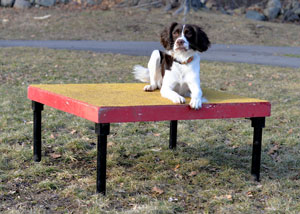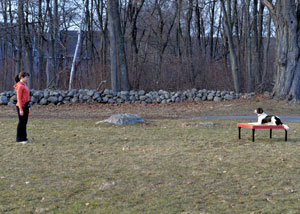Table tribute
The table is the most beginner-friendly dog agility obstacle. It is stable, it is sized to match the dog's height, and it has clear criteria for both the dog and the handler. The table is a training activity that is really simple for new trainers to teach, yet it is often loathed by agility handlers. They label the table "boring" or "a waste of time." However, when done correctly, training your dog to perform with a table is fast and fun for all members of the team!

Equipment specs
Begin by using the lowest table possible. Most tables have detachable tops and changeable legs of varying heights. I usually start with just the top of the table on the ground or, with a large dog, I'll use the 4" table legs to give the table a little bit of height. My goal is to get the behavior fluent first, and then build height.
It may not be necessary to raise the height of the table at all. If you don't plan to compete, you can choose to use just the top of the table. If you have competitive aspirations, check the rule book of your preferred agility organization and learn what height the table will be in competition. That way you know what your specific goal is!
Introducing the table

Click when your dog makes an initial
interaction with the table.
To get started, click when your dog makes an initial interaction with the table. That interaction might be sniffing the table or even just looking at the table. Deliver the treat to your dog or toss the treat on the ground by your dog's front paws, whichever is easiest for you.
After clicking the dog's initial interactions with the table, click when your dog makes contact with the table using one or more paws. Some dogs will place one or two front paws on the table tentatively, while others will just hop right on. After the click, toss the treat off the table to reset your dog for the next repetition.
At no point should you point at or gesture toward the table. Keep your body language quiet and neutral. Allow the dog to figure out what behaviors earn clicks and treats.
When your dog leaps on the table with all four paws consistently, delay the click and see what your dog offers. Wait for her to offer a sit, down, or bow. If you have a very antsy, fidgety dog, you may choose to click the dog merely for standing still. Remember, don't prompt your dog! Wait her out and see what clever behavior she comes up with. When she offers a stationary behavior, click and throw the treat off the table.
At any point during the training, feel free to use your dog's release cue (such as "okay," "break," or "off") in lieu of a click.
A word about positions
The position your dog needs to demonstrate on the table varies, depending on the organization in which you plan to compete, if you plan to compete at all. Most American agility organizations have changed their rules to accept a "position-less table" where the dog may assume any position on the table. The United States Dog Agility Association (USDAA) always requires a down.

I encourage my students to teach
an automatic down.
I encourage my students to teach an automatic down on the table, regardless of the venue in which they hope to compete. For the automatic down, as soon as the dog gets on the table, she must orient back to the handler and lie down—with no prompting from the handler.
I suggest this behavior because it is a behavior that is incompatible with leaping on to the table and using it as a springboard to leap right off. The springboard action is a common behavior for dogs with a bouncy stride (like many small breed dogs) and for large dogs that are much taller than the table they see in competition. If the dog is focused on shifting her weight to assume a "down" position, she cannot also be leaping up and forward.
If your dog isn't offering any downs, move away from the table. Cue the dog to lie down, and click and treat that behavior. Repeat about ten times. Then, move back to the table and wait to see what your dog does. Alternatively, if your dog knows to lie down on a mat, try placing the mat on the table.
Back to training: Height
If agility trials are in your dog's future, and if you were successful in training a position behavior on a table that is lower than your dog's competition table height, now is the time to increase the height of the table. If possible, increase the height a few inches at a time, rather than hiking up the table suddenly. Most manufactured agility tables come with legs that elevate the table to set heights, such as 8", 12", 16", 20", and 24" or 26".
In my experience, elevating the height of the table doesn't tend to faze dogs as long as it is done gradually—two to four inches at a time for small dogs, four to six inches at a time for large dogs. If you increase the height of the table and your dog becomes increasingly hesitant to climb on, go back to a height that was manageable for your dog. If your dog is successful at one height hike but switching to the next height is too much of a stretch, use bricks or paving stones to provide a more gradual increase in height.

Gradually build the distance you are from the table.
Duration
Once your dog is consistent about lying down on a table of the desired height, it's time to build duration. Do this slowly as well—a half-second at a time. Wait for your dog to lie down on the table, wait a half-second, then click and toss the treat. Your goal should be to build to a minimum of five seconds, which is the duration required in competition. Build duration on the table gradually, mixing in some short-duration repetitions (one or two seconds) with longer-duration repetitions (three to five seconds) to keep things interesting for the dog.
Distance
Next, build the distance you are from the table, again one step at a time. Just as you did with duration, ping-pong your distance from the table. Start with 2 feet, then 4 feet, then 1 foot, then 6 feet, then back to 4 feet. You get the idea!
Distraction

Click and treat your dog for staying on
the table while you attempt to distract her.
The next step is to click and treat your dog for staying on the table while you attempt to distract her. Try distractions like turning your back on your dog, walking or sprinting away from your dog, dropping a treat on the ground before you have clicked, bouncing a ball, or swinging a tug toy. Be creative and have fun!
Behavior chain
The last step of the table-training process is to incorporate the new table behavior into agility sequences, thereby creating a behavior chain. Add a jump, tunnel, or other obstacle that your dog knows well before or after the table behavior to build your dog's understanding. It is more challenging for the dog to get on the table at speed mid-sequence, so my preference initially is to start sequences with the table (table-jump or table-tunnel, for example). When the dog is doing that well, I add the table to the middle or end of a sequence, too.
Success where it matters
Teaching your dog to lie on a table is a great way to build your dog's confidence and expand her training repertoire. Table work is a fun extension of the popular "get on your mat" behavior. I like to start novice agility dogs with the table, because I find that behavior increases initial success with the A-frame and dog walk. Dogs are eager to jump on to anything that resembles their table!
Remember to have fun and enjoy the process of teaching your dog, whether or not table behavior is destined for competition or for home play. In either case, your mutual success will strengthen the bond between you and your dog. Happy training!
Related Products
|
|
|






Post new comment